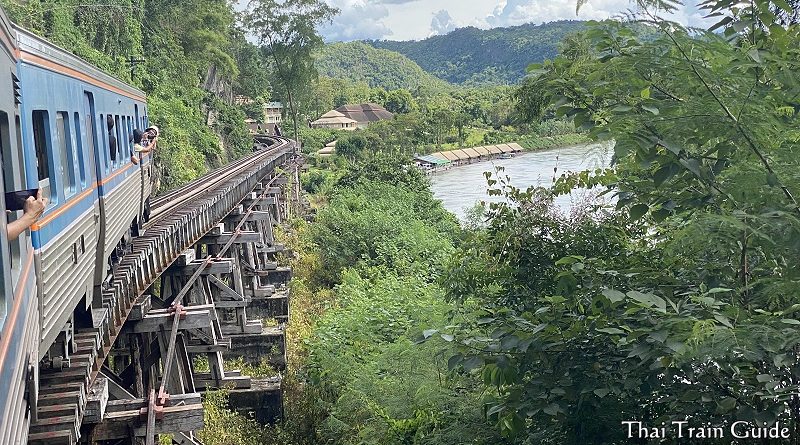
A Complete Guide to The Death Railway
One of the most popular railway lines in Thailand for foreign tourists is the Death Railway. It stretches from Nong Pla Duk Junction Station in Ratchaburi to Nam Tok Station in Kanchanaburi. While most independent tourists begin their journey from Thonburi Station in Bangkok, tour groups usually board at either Kanchanaburi Station or River Kwai Bridge Halt. The tour guides do like this because the train ride to Kanchanaburi, lasting two and a half hours, is not particularly scenic. However, it becomes more interesting once you reach the Bridge on the River Kwai. Another option for travelers is the weekend excursion train to Sai Yok Noi Waterfall, which also follows the Death Railway. This train offers a return day trip with several stops along the way.
RELATED LINKS:
- How to go by train on the Death Railway
- Stations along the Death Railway
- Schedule for the Death Railway
- Map of the Death Railway
- Walking the Death Railway
- Books about the Death Railway

Thonburi Station is the main departure point in Bangkok for trains heading to Kanchanaburi. Two trains operate daily: Local Train No. 257 departs at 7:45 a.m., and No. 259 departs at 1:55 p.m. If you plan on returning on the same day, it is advisable to catch the earlier train. Regardless of the distance traveled, foreigners are required to pay a fixed fare of 100 Baht for this line. Tickets for trains on this line cannot be purchased online or in advance. Simply arrive at the station approximately 30 minutes prior to departure and purchase tickets at the ticket office. There are several options available nearby to grab breakfast and coffee. Rest assured, tickets will not sell out.

This is the diesel locomotive that will transport you to Kanchanaburi. At this terminal station, there are multiple trains awaiting departure, so be sure to board the correct one. Look for the train with the destination sign ‘Thonburi to Nam Tok’. In Thai, Nam Tok means waterfall. The current terminus of the Death Railway is Sai Yok Noi Waterfall.

The train consists only of 3rd class carriages equipped with fans and open windows. Seat numbers are not assigned, so you can choose any available seat. As the train is a bit mismatched, it’s recommended to walk through the carriages until you find a comfortable seat. For the best views after Kanchanaburi town, try to secure a window seat on the left-hand side, facing the direction of travel. Additionally, ensure that there is a functioning fan above you. While the train is in motion, the open window provides natural air conditioning, but delays can make it hot without the fan.

The first point of interest is the Nong Pla Duk Junction Station, which serves as the official starting point of the Thai-Burma Railway. If you’re on the morning train, expect to arrive at 9:21 a.m. As you look out of the right-hand side of the train, you’ll notice a boulder with an inscription commemorating the start of construction on September 16th, 1942. For those on the afternoon train, arrival time is around 3:21 p.m. Shortly after departing this station, the train will transition from the Southern Line onto the branch line leading to Kanchanaburi. Additionally, there is another branch line here that leads to Suphanburi.

The first major stop on the journey is Kanchanaburi Railway Station. The morning train arrives at 10:25 a.m., while the afternoon train arrives at 4:24 p.m. In theory, you could disembark here and spend a night or two in Kanchanaburi town before continuing the journey on another day. However, it’s important to note that since many people board the train at this station, not everyone will secure a window seat on the left-hand side!

After approximately fifteen minutes, your train will arrive at the infamous ‘Bridge on the River Kwai’. This is the original bridge that was constructed during the Second World War. The concrete pillars still bear visible shrapnel damage, while the middle section was destroyed by Allied bombers. The curved arches at each end remain in their original form, while the straight ones in the middle were added after the war. On the left side of the bridge, about 100 meters away, there used to be a temporary wooden bridge. It served as a precursor to this more permanent structure. However, the wooden bridge was dismantled after the war, and nothing remains today except for a short replica displayed in a nearby museum.

This is the view you get of the bridge while you are crossing it on a train. If you have time, I would advise you to ride the train and watch it cross the bridge trackside. I stayed in a hotel near the bridge on the second night of my last trip here. You can either get off here at the halt before the bridge or come back later and stay the night.
RELATED LINK: Times For Taking Photos Of Trains On The Bridge On The River Kwai

The next point of interest is a cutting that was constructed by prisoners of war. While it may not be as long or dramatic as Hellfire Pass, it holds its own significance. Located near Chungkai War Cemetery, which once served as a prisoner of war camp, this cutting can be reached within ten minutes after crossing the bridge.
Keep an eye out for black telegraph poles on the left-hand side, each marked with numbers. These serve as kilometer markers. Your target is pole 125/3, indicating it’s the third pole after the 125-kilometer marker. The cutting is straight after this pole.
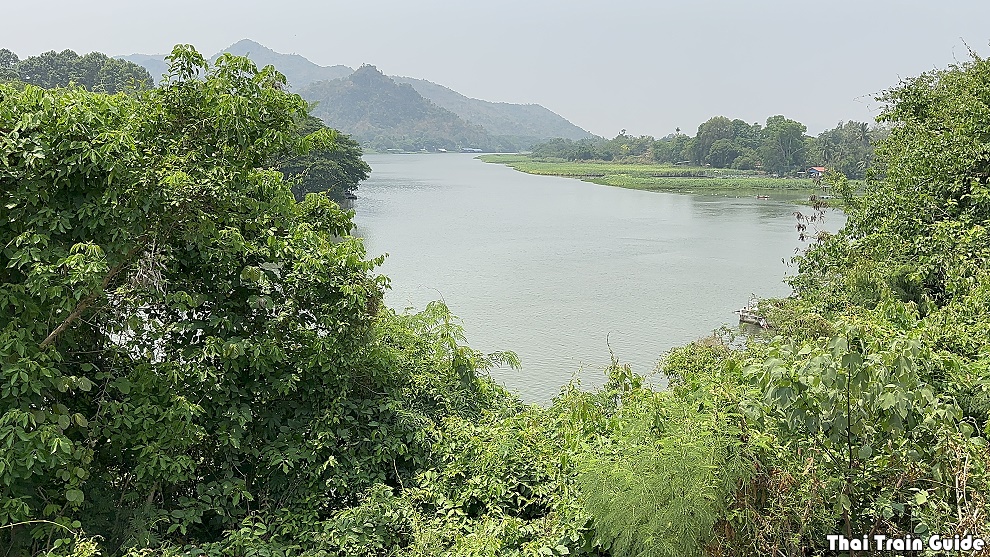
Right after the cutting, you’ll have a clear view on your left of the Khwae Noi River. The bridge you crossed earlier spans the Khwae Yai River, which is a separate tributary to the Maeklong River that eventually reaches the sea. It’s worth noting that “Yai” means big and “Noi” means small. In the movie, the River Kwai was mispronounced; it should actually be Khwae, which rhymes with square.
RELATED LINK: Is It The River Kwai Bridge Or River Khwae Yai Bridge Or Maeklong Bridge?
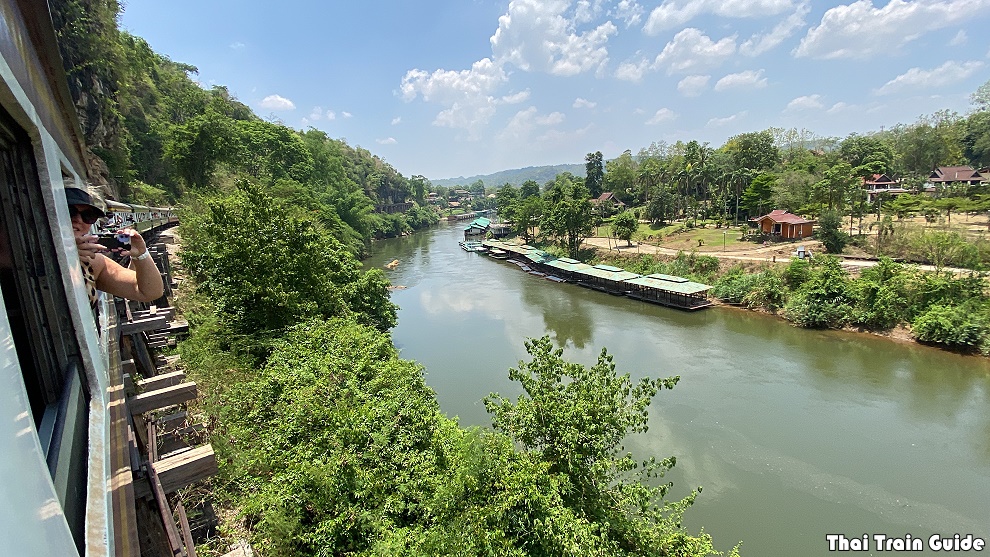
One of the main attractions of this route is crossing the Tham Krasae wooden viaduct, which runs alongside a cliff above the Khwae Noi River. It’s located just over an hour away from the River Kwai Bridge. If you’re looking out for the telegraph poles, keep an eye out for 173/17. The train moves very slowly in this area due to occasional pedestrians on the track. Please exercise caution while on the train, as there have been cases of people falling to their death.

You have the option to get off after the wooden viaduct at Tham Krasae Halt. I’ve done that a couple of times. There is an interesting cave there, and you can also walk across the wooden viaduct. Just make a note of the train times. They don’t come often, and they will sound their horn as they expect people on the tracks. But please note, there are special excursion trains on the weekend. There are several riverside resorts here where you can stay for a night or two.
RELATED LINK: Times For Taking Photos Of Trains On The Tham Krasae Wooden Trestle Bridge
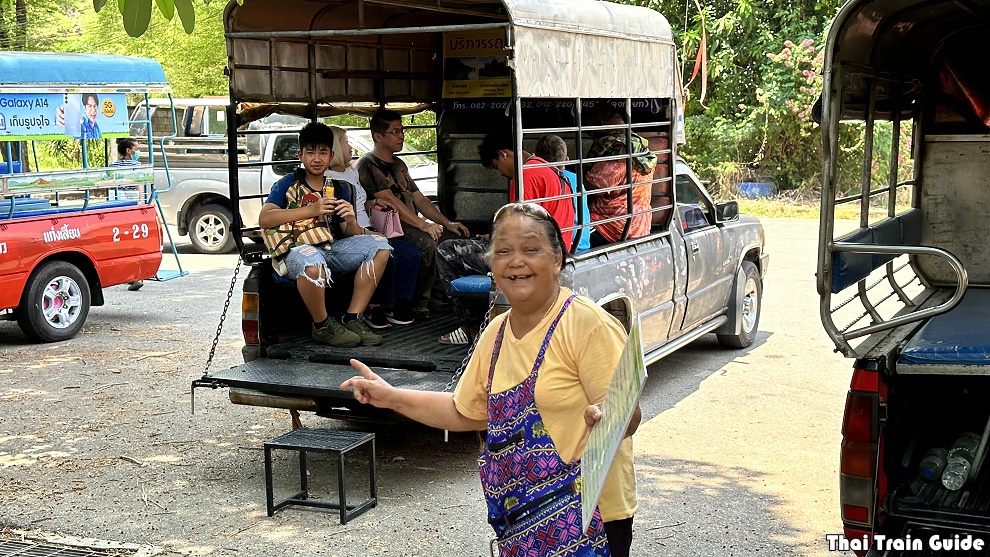
Beyond Tham Krasae, the train continues its ascent into the hills, offering picturesque views. Thais call this “Little Amazon”. Occasional breaks in the vegetation reveal glimpses of the river below, on your left-hand side. From Tham Krasae, it takes approximately 40 minutes to reach the final stop at Nam Tok Station. If you take the morning train, you will arrive at 12:35 p.m. For those on the afternoon train, arrival is expected at 6:30 p.m. At Nam Tok, you’ll find songtaews waiting to transport you to the nearby Sai Yok Noi Waterfall.
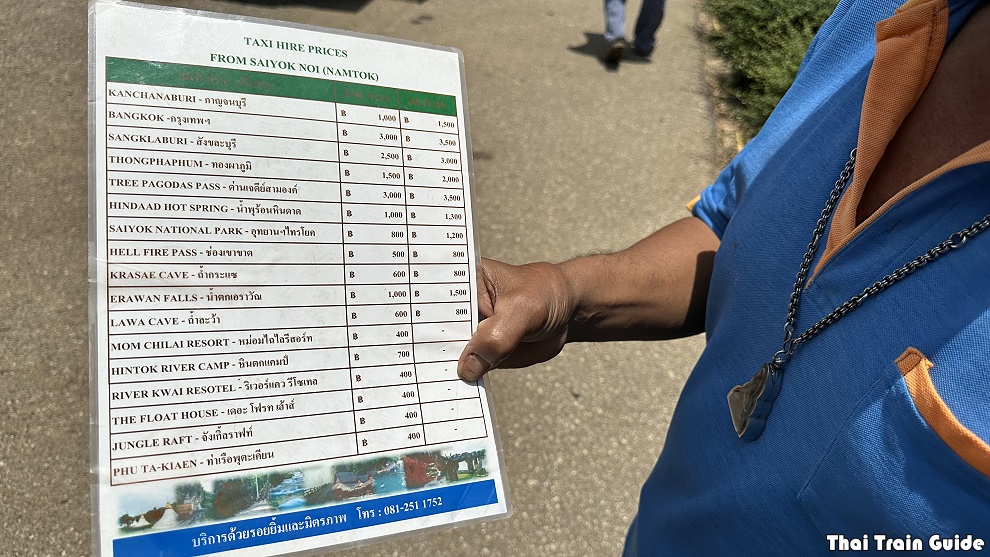
You also have the option to rent a songtaew to go wherever you want. For instance, a round-trip to Hellfire Pass costs 800 Baht. If you’re staying at a resort by the river, the songtaew driver can also take you there.
If you plan on returning by train, there are only two options available. The morning train departs at 12:55 p.m., giving you a mere 20-minute window. The next and final train leaves at 3:30 p.m., but it only goes as far as Kanchanaburi. If you choose the latter train, you’ll have approximately three hours, which should be enough time to visit Hellfire Pass. In case you miss the last train, there is a small hotel near the station. Alternatively, you can walk to the main road and catch any southbound bus heading to Kanchanaburi.


Hello,
We are travelling to Bangkok next week, and we’d like to take the touristic train. I’ve been trying to find tickets for April 13th but there’s nothing on D-Ticket for that day.
Is it because Songkran festivity?
We are also staying in Kanchanaburi from April 8th to 10th, could we take the regular line to Nam Tok (train 485)?
Thank you!
Correct, there are no tourist trains for the Songrkan holiday. And yes, you can take the daily train there from Thonburi.
Hi Richard, i would like to ask, i’m staying near saphan kwae station. 1) if i would like to take the train to Nam tok and back , what would be the best time and how long would that take ? 2) Any tips i.e. buying ticket in advance planning to go on a monday / tuesday.
You can only buy these tickets at the station on the day. If you scroll up you will see the latest schedules.
Hi, I’m seeing so much information about this train I’m lost. I’m looking to do the tourist trip that stops off along the way this Sunday. Will it depart from Thon Buri or Hua Lamphong station, if anyone knows, please advise how or where I can book or pick up tickets and please advise the time of departure as I thought it was around 07:00 ish? Thanks all. Stuart
That is the weekend tourist train No. 909. It leaves from Hua Lamphong at 6:30 a.m. You must buy tickets in advance as it always sells out. I just checked and there are a couple of seats left. Buy now on the D-Ticket website or at your local railway station.
THANK YOU so much for your help and advise. Booked tickets on D as you said and enjoyed our day yesterday, (Sunday 10th) All went well and jumped off at Kanchanaburi to spend a few nights here! Spot on sir!
Thank you for this post it was immensely helpful and detailed! Just to clarify, if we choose to get off after the wooden viaduct at Tham Krasae Halt at around 11:38, we won’t be able to take the same train further on to Nam Tok right? Unless we wait for the next train which is almost 6 hours later at 17:46, or if we take the train back to Kanchanaburi station that will be 2 hours later at 13:28? Also, where do we check the weekend schedule?
Hello, I would also love to know if there are taxis or Grab to take you directly from Hellfire Pass to Kanchanaburi, rather than catching the train?
Hellfire Pass is in the middle of nowhere. You would have to arrange transportation in advance. To take you there and back.
Hi, loved your post, very informative.
If I was to get off at the Tham Krasae Halt are there taxis (or buses) available to take you back to Kanchanaburi? Rather than going all the way to nam tok if short on time. Thanks
I would have to take a closer look as I didn’t notice any. The thing is, there are a lot of minivans and buses in the parking lot there, but I think they are all for tourists on tours.
Hi Richard,
Coming from Hatyai, I want to avoid having to go all the way to Bangkok first to board the #257 from Thon Buri.
I researched that there’s alternative way to Kanchanaburi by boarding 2 separate trains:
1) Hat Yai to Nakhon Pathom (Train# 172, 170)
2) Nakhon Pathom to Kanchanaburi (Train #257, 259)
While I can see the first train is available, I cant find booking info for the second train on 12go website. Do you know if it runs this time of the year (Feb 2024)? I know Train#257 is the most popular option as it departs from Thon Buri (the terminal station) but I just can’t see the same train to book and board from Nakhon Pathom..
Thanks Richard,
For local trains, you can only buy tickets an hour or so before departure. So just buy once you reach Nakhon Pathom. There are no seat numbers and so tickets don’t sell out.
Greetings! I’m an Australian railway enthusiast and have visited Kanchanaburi/Nam Tok/Konya Cutting several times but I found out a lot more on this visit thanks to your site!
Last Saturday the tourist train from Thonburi to Nam Tok Sai Yok Noi (the end of the line) only went as far as Nam Tok. It seemed too long for the short platform at the end. Have you heard before of these weekend trains stopping short of their destination? I’ve uploaded a short video to YouTube to show you what happened.
https://youtu.be/GtaYkeMrgtQ
Normally the weekend excursion train is a diesel railcar with a cab at each end. So that train goes to the far end of the line. However, sometimes people rent the SRT Prestige carriage and it is added to regular carriages with a diesel locomotive. As there are no sidings at the far end of the line, that train has to stop at Nam Tok Station so the locomotive can shunt to the other end for the return trip.
Ah that explains it. Your knowledge of these trains is incredible sir. Thank you.
Hi
About 7 years ago we did an organised 2 day trip around the attractions in Kanchanaburi which included a ride on the death railway.
It wasn’t a very long trip on the train as I remember
We are returning in April and are planing on sorting a trip with hire car from Bangkok to Kanchanaburi ourselves. What station would you advice to get on and off to give our friends the experience of the train ride over the viaduct etc to where the travel groups would take you?
I personally wouldn’t get on too late as you might miss out on a window seat on the left. Best to get on at Kanchanaburi Station and then ask your driver to pick you up at Tham Krasae. But it is actually beautiful all the way to the end at Nam Tok.
Thanks for this very informational page.
Already booked to arrive in Kanachanaburi on 21st January 2024.
On the 23rd back to Bangkok, I plan to do the morning Train#257 trip towards Nam Tok.
Would you recommend 1) Stopping at Thamsae Bridge for more time of photography & quick-bite lunch and take Train#258 to BKK , as to 2) going onward to Nam Tok and back? Is the scenery toward Nam Tok (and back) worth it?
I would say yes to both! But the first option is better if you don’t have time to do both over two days. Beyond Tham Krasae there’s a section Thais call “Little Amazon” which is quite beautiful.
Thanks for that! We might do the tour in two weeks time.
But if you take the second train back, how do you get from Kanchanaburi to Bangkok? As per Google maps, it’s still 2hrs40 by car, is that correct? So there is no way to get back to BKK the same day if you want the three hour break?
You can go to the bus terminal in Kanchanaburi and just get the bus back to Bangkok. Or stay the night in one of the many hotels near the station and the river.
Bonjour,
merci pour votre site qui est une mine d’or pour moi. j’organise un séjour en famille avec nos 3 grands ados de décembre/janvier 2023.
pour les prix des voyages en songtaew que l’on voit sur la photo, pouvez vous m’indiquer si c’est le prix pour le voyage quelque soit le nombre de personnes ou si c’est le prix par personne ?
arrivée à Nam tok, je voudrais prendre un songtaew pour faire le circuit : hell fire pass, erawan falls, notre hotel au bord du lac de sinakarin. je voudrais me faire une idée du tarif à partir de votre photo.
merci d’avance de votre réponse.
Yes, it is the cost to rent the songtaew. One price for all your family.
Thank you Richard! I had a wonderful train trip to Nam Tok and even better time chatting with the locals. Keep up the great work with the resources 👏
Thanks for the feedback.
the 2nd station after Thonburi, Jaransanitwong is better, as it connects to MRT Bang Khun Non. Also: you can just buy the ticket ON the train, as there is no ticket office there.
Good tip! Thanks. Though you have to hope not many people get on the train at Thonburi. If everyone knows you need a seat on the left by the window facing forward then you won’t have so much choice if you get on later. Plus, I like to walk up and down to work out which fans are working or above which seats. Also some carriages have hard seats. So I am a bit fussy. Getting on at the first station makes this easier.